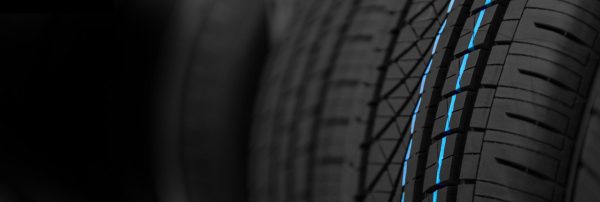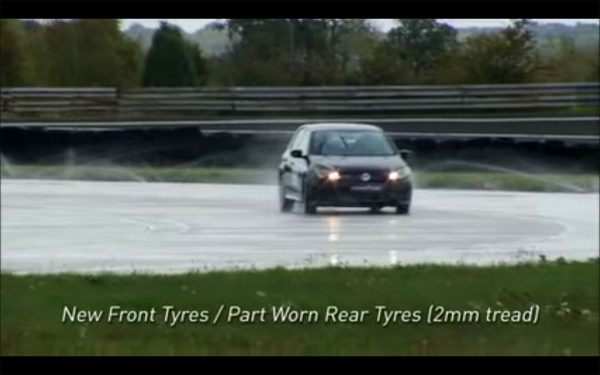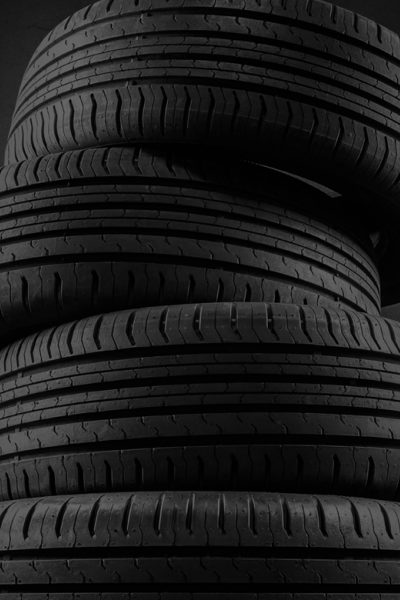
chamber of horrors
Are your tyres in trouble?
Dangerous and worn tyres can take many shapes and forms and some can be illegal for a variety of reasons. Check out our collection of illegal tyre examples below and see if your tyres resemble any of these infamous outlaws.
Under inflation
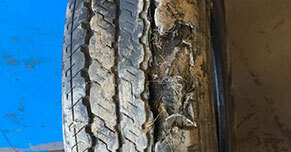
Causes wear on outer edge of the tyre, which leads to a dip in the middle. You will need to inflate your tyres to the required pressure for your vehicle.
Over inflation
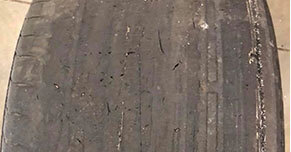
Causes increased wear on the centre, as your tyre bulges in the middle from being over-inflated. You’ll need to check the required tyre pressure for your vehicle found in the car manual.
Mis-alignment

Causes uneven wear on one side.
Cuts
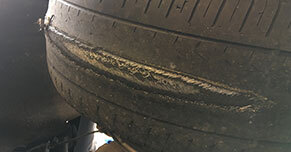
Sharp objects can cause considerable damage rendering a tyre unserviceable.
Camber wear
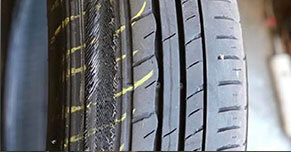
Causes sloping wear on the outer edge, and is illegal to drive.
Impact damage
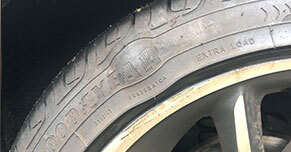
This is damage caused by an impact to the sidewall. The bulge or "egg" indicates localised casing damage.
Illegal or dangerous wear
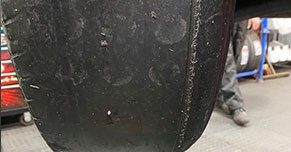
This tyre has been used well after reaching the legal minimum pattern depth of 1.6mm.
End of life
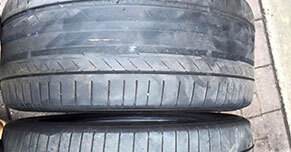
This tyre has reached the legal minimum pattern depth of 1.6mm.
Emergency breaking
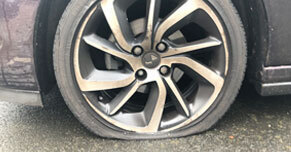
An emergency braking manoeuvre with this tyre has caused the tyre to rapidly wear through the complete casing causing the tyre to deflate.
avoiding tyre troubles
Naturally, tyres wear as they are used. However, there are a couple of things you can do to prevent how fast this occurs. Such as:
- Make sure you get your wheels aligned regularly, your tyres will wear unevenly if your wheels are misaligned.
- Drive on correct tyre pressure. Having both underinflated and overinflated pressures will cause uneven tread wear.
- Make sure you are loading your vehicle to the advised weight for your tyre. Overloading your vehicle can cause your tyres to overheat which increases the risk of an accident.

What the law requires
Driving with worn tyres is not only very unsafe, but could land you with a hefty bill too. In the UK there is a £2500 fine for bald tyres PLUS 3 points on your license, for each tyre.
Overtime your tyres will wear down and if you don’t keep an eye on them, they could become illegal.
Regulations govern many aspects of tyre condition of which the following are the principal points:
- Tyres must be suitable (i.e. of the correct type and size) for the use to which the vehicle is being put and must be inflated to the vehicle or tyre manufacturers' recommended pressures.
- Tyres of different types must not be fitted to opposite wheels of the vehicle (for example, radial-ply tyres must not be fitted to a wheel on the same axle as wheels already fitted with cross-ply tyres and vice versa, and a two-axle vehicle with single rear wheels must not have radial ply tyres on the front axle if cross ply tyres are fitted to the rear axle).
- No tyre must have a break in its fabric or a cut deep enough to reach the body cords. No cut must be more than 25mm or 10 per cent of the tyre's section width in length, whichever is the greater.
- There must be no lump, bulge or tear caused by separation or partial fracture of its structure, neither must any portion of the ply or cord structure be exposed.
You can avoid issues like these by doing some regular &
simple tyre checks to keep you safe on the road. See below for our
recommendations.
MINIMUM TREAD DEPTH
Tyres on cars, light vans (not exceeding 3,500kg gross weight) and light trailers must have a tread depth of at least 1.6mm* across the central three-quarters of the breadth of tread+ and in a continuous band around the entire circumference of the tyre. * For goods vehicles over 3.5 tonnes the minimum tread depth requirement remains at 1mm (along with other requirements). + Breadth of tread means the width of that part of the tyre which is in contact with the road surface under normal conditions.
There are some very simple things you can do to check how much tread you have left over and above the legal limit;
THREAD WEAR INDICATORS
Each
tyre has a clever mechanism to quickly and easily find out how much
tread your tyre has left before it gets to the legal limit (1.6mm) – a
tread wear indicator. These are bars of rubber molded into the tread
grooves to indicate 1.6mm. When your tyre is worn to the legal limit,
the bars will be flush with the rest of the tread surface.
On the sidewall of your tyre you will see a small arrow – or on the below example Goodyear use the iconic wingfoot, to indicate where the molded bars are found.
RUN FLAT AND TEMPORARY USE SPARE TYRES
Regulations permit the legal use of 'run-flat' tyres (provided they are identified as such) in a partially inflated or flat condition, and what are described as temporary use spare tyres. When a temporary use spare tyre is being used, the vehicle speed must not exceed 50mph, and a special high inflation pressure is normally used, otherwise the legal provision which permits their use ceases to apply. The temporary use spare tyre or the wheel to which it is fitted must be of a different colour to the other wheels on the vehicle and a label must be attached to the wheel giving clear information about the precautions to be observed when it is being used.
TYRE MAINTENANCE
Tyres will provide greater life if they are properly maintained - it is an inexpensive task which takes only a few minutes at regular intervals. The following Check List will be helpful in this task:
Check the correct pressures against the manufacturer's recommendations as given in the vehicle Handbook.
- Adjust pressures as necessary.
- Clean dirt from valves and fit valve caps all round.
- Remove stones and other foreign objects from treads.
- Have the steering alignment checked if front tyres show signs of excessive or uneven wear.
- Examine brakes if tyres show signs of wear through wheel locking.
- Have front wheels and tyres balanced if there are signs of vibration, wheel wobble or patchy tyre wear.
